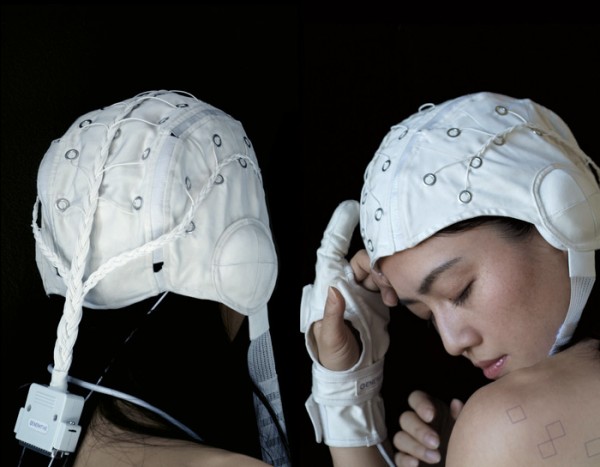Art Review | Alex Dodge: Generative

by Tyler Coburn
September, 2010
Visitors to 438 Union Avenue may be surprised to note that scrappy gallery Klaus von Nichtssagend appears to have gone the way of other mid-noughties Brooklyn establishments, replaced by a white-on-white outpost of Apple-esque technology prototypes, courtesy of artist Alex Dodge and his registered LLC, Generative. There, on a grey trade-show carpet within a perimeter of recessed fluorescents, a visitor can lounge prone on a massage table and lose not a New York multitasking minute, thanks to a suspended computer workstation, or admire the sheen and finishing of Wearable Interface (GEN-1J) (all works 2010), a ‘cross-seasonal jacket’ equipped with onboard processor, USB ports and microphones, which provides real-time responses to a user’s environment, be it a wooded terrain or (likelier) rooftop cocktail party.
The fibrous Haptic-Synth shirt, which would have been at home in the S/S 10 Rick Owens collection – or antique undershirt emporium – gains in the way of chic from an allover grid of touch sensor ‘cells’, which users can programme to pair with specific devices. Good looks notwithstanding, aesthetics is but a hook to get this shirt onto the consumer body, and get the consumer back in touch with her nonvisual faculties. An accompanying rubber widget, customised to fit a user’s hand and fingers, conjures a porcelain joystick as conceived by a medieval votary. Better that the future be cold-cast in the fetishes of the past, in other words, than stitched into the black leather and vinyl that made Keanu and Carrie-Anne such pedantic dystopians. Sociotechnological immersion, our lifestyle brands now insistently promise, will lead the way to utopian possibility – though that road, it must be said, will be paved with products.
In this sense, Dodge’s exhibition does an admirable job of capturing the ambivalence that many of us feel at the fact that ours is a future to be consumed, and that our relationship to the key companies offering this up can no longer be tenably polarised along the little man/big man axis. This complexity is aptly conjured by Dodge’s occupying a position that is not wholly satirical, critical or fannish. To the artworld’s long history of performative corporatisation, he delivers the real deal, through actual incorporation; and through exacting personal and collaborative labour, he produces prototypes for interfaces that are potentially realisable – and that pass for big-budget design-studio fare. These efforts go some distance to qualifying the potential cynicism that could attend to this thinly veiled parody, which only strains tolerance in Ringo Newton, a 3D animation that has an apple drop and roll across a white background, disclosing Generative’s logo. Indeed, Dodge’s meticulous work adds an inspiring quality to these often deeply considered prototypes, jogging us anxious consumers with the slightest bit of fancy.